Available with Location Referencing license.
The Add Line Event tool allows you to add line events to dominant routes where route concurrencies exist.
Concurrent routes
Concurrent routes are routes that share the same centerlines; that is, they travel the same pavement but are modeled with different measures. This relationship may exist to model two routes with different directions of calibration, or to model locations on highways where multiple routes converge into a common roadway for a subset of their paths. Where these concurrent routes exist, you can use a set of rules to choose a route that's considered dominant.
You can add line events to dominant routes using the Add Line Event tool. For example, in the following image, there are three routes with route IDs of 100, 200, and 300.

The route dominance rule is set as the lesser the route name, the more dominant the route. Using this condition, route 100 is the most dominant route, and routes 200 and 300 have the same order in dominance.
To add line events from the start to the end of route 200, that process is done in four sections as shown in the following image and table:
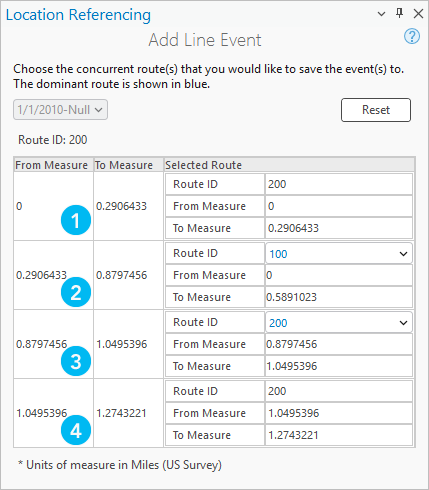
The callout numbers in the image above correspond to the numbers in the following table:
| Section | Description |
|---|---|
 | Route 200 is the dominant route because no other route exists in this section; the event is added to route 200. |
 | Route 100 has the greater order of dominance; the event is added to route 100. |
 | Both route 200 and route 300 have the same order of dominance; the event is added to the route of your choice. |
 | Route 200 is the dominant route because no other route exists in this section; the event is added to route 200. |
Note:
- Configure route dominance rules to access this functionality.
- Events in the attribute set must belong to the same network as the selected Route ID value.
- You can add events to one route at a time.
Concurrent routes with different time ranges
The following image shows concurrent routes with different time ranges:
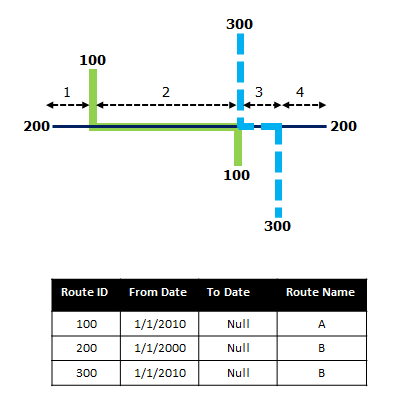
Route 200 has a start date of 1/1/2000, and route 100 and route 300 both have a start date of 1/1/2010. As a result, if the selected start date of the event is 1/1/2000, there are two route time ranges as follows:
- 1/1/2000 to 1/1/2010, when only route 200 existed.
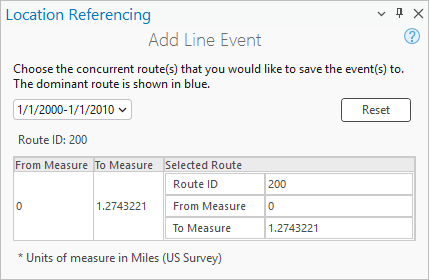
- 1/1/2010 to Null, when all three routes existed.
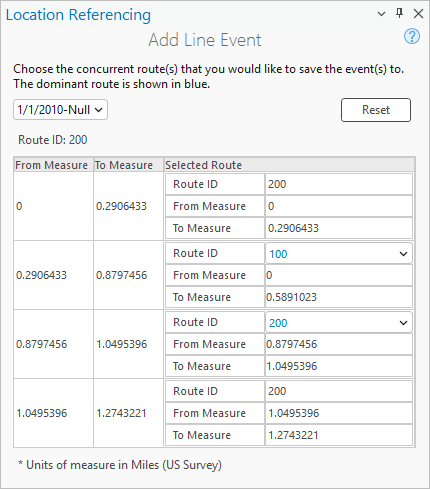
Add the line events
To add line events to dominant routes, complete the following steps:
- Open the map in ArcGIS Pro and zoom to the location where you want to add the line event.
- Click the Location Referencing tab, and in the Events group, click Add > Line Event
 .
.The Add Line Event pane appears with the Route and Measure default value for the From Method and To Method options.
Using the Route and Measure method, the measure location is based on the measure values from the selected route.
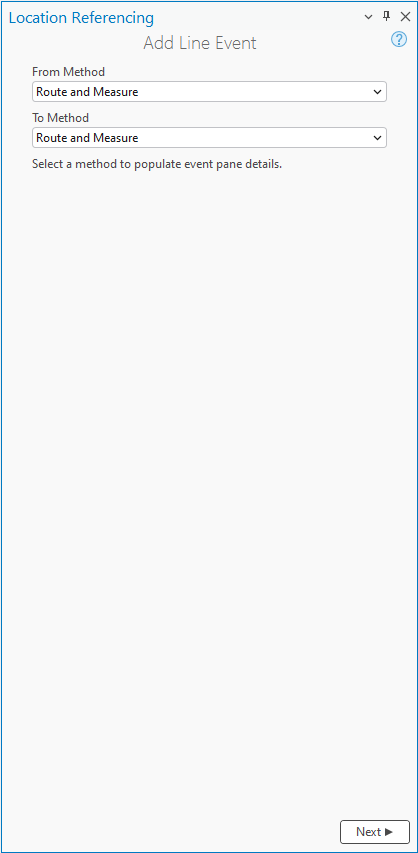
- Click Next.
The From: Route and Measure, To: Route and Measure, and Dates sections appear in the Add Line Event pane.
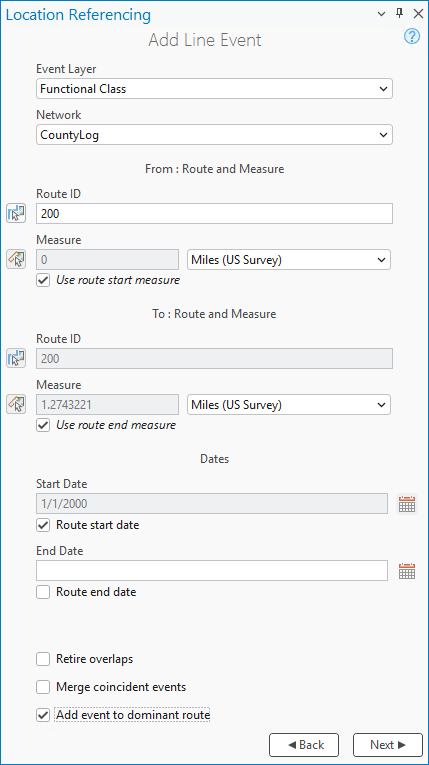
- Click the Event Layer drop-down arrow and choose the line event layer.
The Network layer is automatically populated once the event layer is chosen. The network serves as the source linear referencing method (LRM) to define the input measures for the event.
The network is an LRS Network published as a layer in the feature service.
- Click Choose route from map
 and select the route on the map to populate the Route ID value.
and select the route on the map to populate the Route ID value.Note:
If a message regarding acquiring locks or reconciling appears, conflict prevention is enabled.
- In the From: Route and Measure section, specify the start measure by doing one of the following to populate the Measure text box:
- Click Choose measure from map
 and select the start measure value along the route on the map.
and select the start measure value along the route on the map. - Check the Route start date check box.
- Provide the start measure value in the Measure text box.
A green point appears at the selected location on the map.
- Click Choose measure from map
- Optionally, in the To: Route and Measure section, specify the end measure for the new line event along the route by doing one of the following to populate the Measure text box:
- Click Choose measure from map
 and select the end measure value along the route on the map.
and select the end measure value along the route on the map. - Check the Use route end measure check box.
- Provide the end measure value in the Measure text box.
A red point appears at the selected location on the map. The event will be created between the green and red points.
- Click Choose measure from map
- Specify the start date of the event by doing one of the following:
- Click Calendar
 and choose the start date.
and choose the start date. - Provide the start date in the Start Date text box.
- Check the Route start date check box.
- Double-click in the Start Date text box to use the current date.
The start date default value is the current date, but you can choose a different date using the date picker.
- Click Calendar
- Optionally, specify the end date of the event by doing one of the following:
- Click Calendar
 and choose the end date.
and choose the end date. - Provide the end date in the End Date text box.
- Check the Route end date check box.
- Double-click in the End Date text box to use the current date.
If no end date is provided, the event remains valid from the route start date into the future.
- Click Calendar
- Choose a data validation option to prevent erroneous input while characterizing a route with line events:
- Retire overlaps—The measure, start date, and end date of existing events are adjusted to prevent overlaps with respect to time and measure values once the new line event or events are created. For more information, refer to Retire overlaps scenarios.
- Merge coincident events—When all attribute values for a new event are exactly the same as an existing event, and if the new event is adjacent to or overlapping an existing event in terms of its measure values and its time slices are coincident or overlapping, the new event is merged with the existing event and the measure range is expanded accordingly. For more information, refer to Merge coincident events scenarios.
- Retire overlaps—The measure, start date, and end date of existing events are adjusted to prevent overlaps with respect to time and measure values once the new line event or events are created. For more information, refer to Retire overlaps scenarios.
- Check the Add event to dominant route check box.
- Click Next.
The route dominance table appears in the Add Line Event pane.
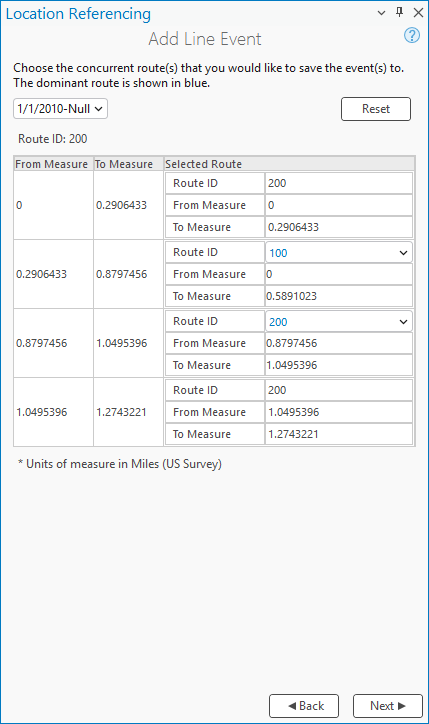
The From Measure and To Measure columns show the values for each section of the chosen route from the previous pane. The From Measure and To Measure boxes under Route ID show the value for each dominant route where the events are added.
A route ID in black text without a drop-down arrow signifies that there was a single route in that section. A route ID in blue text with a drop-down arrow signifies that there are concurrent routes in that section, and the route in blue text is selected automatically based on the route dominance rules. You can manually select any other route using the drop-down arrow.
If you checked the Merge coincident events check box, the records in sections 3 and 4 are merged because they have the same route ID.
- Click Next.
The attributes for the chosen event layer appear under Manage Attributes.
- Provide attribute value information for the event.
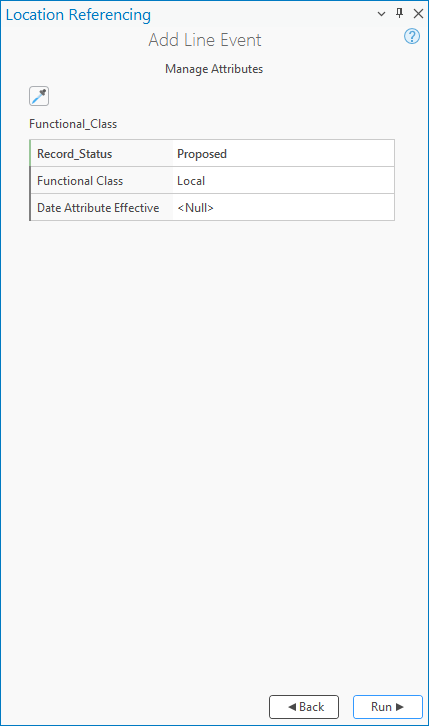
Note:
Click Copy attribute values by selecting event on the map
 and click an existing line event belonging to the same event layer on the map to copy event attributes from that event.
and click an existing line event belonging to the same event layer on the map to copy event attributes from that event.Note:
Coded value domains, range domains, subtypes, contingent values, and attribute rules are supported when configured for a field.
- Click Run.
A confirmation message appears once the line event is added and appears on the map.